To become an adaptive swim instructor, you’ll need water safety certifications, knowledge of various disabilities, and mastery of adaptive equipment. Develop effective communication strategies for all abilities, create personalized skill progressions, and build trust with new swimmers. Implement specialized safety protocols, connect with the adaptive aquatics community, and continuously expand your teaching techniques. Prioritize both water safety and emotional support for your diverse swimmers. Explore these essentials to transform lives through accessible aquatic education.
10 Tips For Becoming An Adaptive Swim Instructor
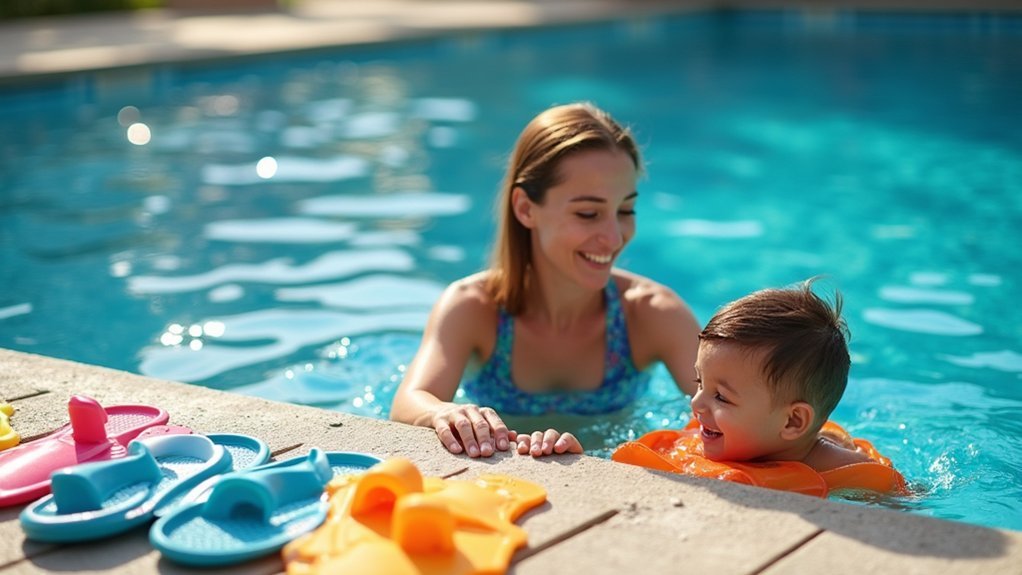
When you decide to become an adaptive swim instructor, you’re starting on a rewarding journey that requires specialized skills beyond standard swim teaching.
You’ll need to develop versatility in teaching methods for various abilities while prioritizing water safety supervision.
Focus on enhancing your communication techniques to effectively connect with diverse learners.
Learn to recognize characteristics of different conditions, including autism spectrum disorder and physical disabilities, as each swimmer requires individualized approaches.
Master the art of adapting your teaching style based on learners’ cues.
Incorporate playful, rhythmic instructions while using appropriate adaptive equipment.
Building trust is essential—establish clear communication with parents and swimmers, set collaborative goals, and create a supportive environment. As part of your professional development, you’ll need to complete Swim Angelfish training within your first month of being hired.
Consider pursuing specialized certifications like the Swim Whisperers® program to deepen your expertise in adaptive aquatics.
Obtain Essential Water Safety Certifications
Before teaching adaptive swimming, you’ll need to obtain proper water safety certifications that validate your competence and guarantee student safety. Start with Red Cross certification, which provides thorough training for swim instructors. You must be at least 15 years old and possess basic water competency certifications to qualify for WSI certification.
Don’t overlook emergency response training, including first aid and assistant lifeguard or Bronze Cross certification. The Red Cross offers convenient digital certificates for easy validation of your credentials.
Emergency response training is crucial for swim instructors—proper certification ensures you’re prepared when seconds matter most.
For specialized adaptive aquatics, consider Swim Whisperers certification, which focuses specifically on teaching students with special needs. This comprehensive multi-level certification program equips instructors with effective tools to address various roadblocks faced by swimmers with diverse abilities.
Remember that certifications require regular renewal through refresher courses. Many training programs now offer online options, making it easier to maintain your qualifications while developing expertise in adaptive swim instruction.
Develop Knowledge of Various Disabilities
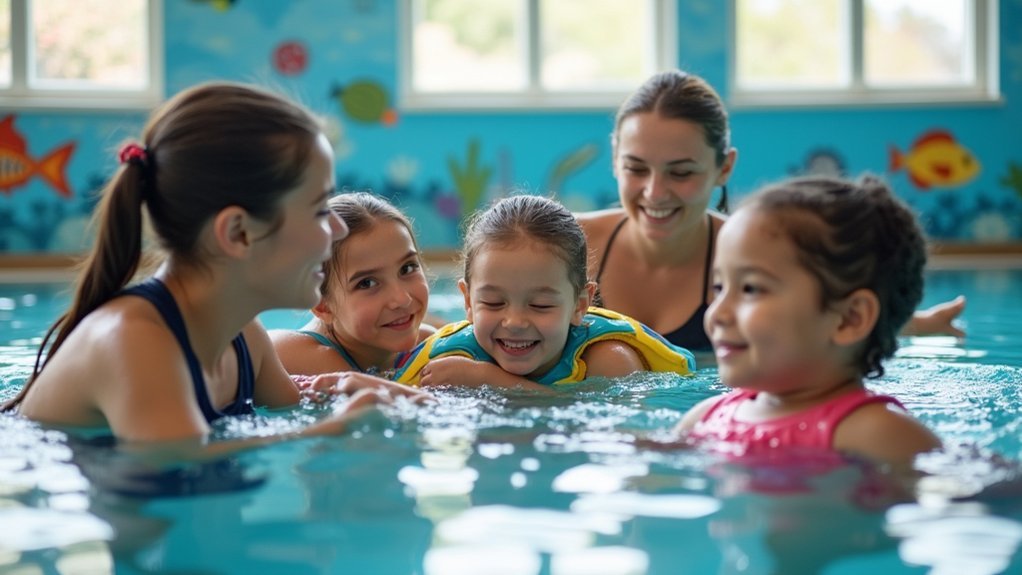
To become an effective adaptive swim instructor, you’ll need thorough knowledge of various disabilities and how they impact aquatic activities. Familiarize yourself with physical disabilities ranging from amputations to hemiplegia, understanding how each affects mobility and technique in water.
Learn about cognitive impairments and how they influence instruction comprehension and attention span. Recognize that students with ADHD or autism may require different communication approaches than those with Down’s syndrome.
Study how sensory impairments create unique challenges—visually impaired swimmers struggle with orientation, while those with hearing impairments miss verbal cues. Mastering communication techniques is essential, as swimmers with hearing impairments face significant barriers when standard verbal instructions are used.
For intellectually disabled swimmers, understand that aquatic interventions provide physical benefits alongside social development.
Create student profiles to customize your teaching strategies, adapting your methods to each individual’s specific needs and abilities.
Master Adaptive Equipment and Buoyancy Techniques
Having established a solid understanding of different disabilities, your next challenge as an adaptive swim instructor involves equipment and buoyancy management. Familiarize yourself with flotation devices like life jackets, swim belts, and noodles that provide essential support for swimmers with limited abilities.
You’ll need to balance equipment use with independence development. Start by integrating support devices for stroke techniques, then gradually wean swimmers off equipment as their skills improve.
Customize buoyancy techniques to each swimmer’s specific needs, adjusting water depth and resistance as appropriate. When planning lessons, incorporate adaptive equipment strategically. Teach swimmers to use flotation devices independently while monitoring their progression.
Remember that equipment should enhance learning outcomes, not replace skill development—your goal is to build confidence while fostering independence. Consider including specialized equipment like swim paddles and gloves to improve propulsion for swimmers with limited strength.
Learn Effective Communication Strategies for All Abilities
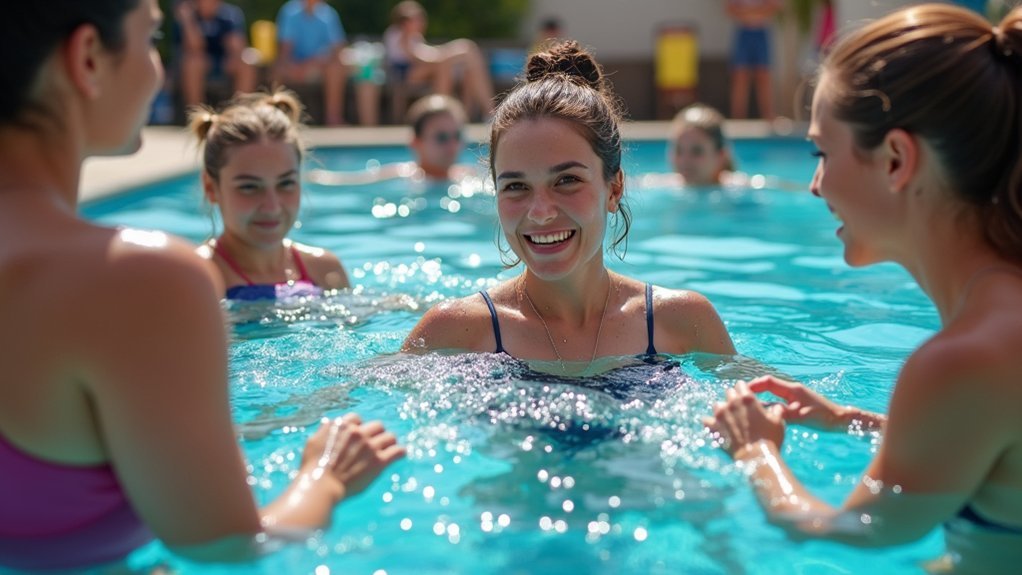
Communication forms the cornerstone of successful adaptive swim instruction, especially when working with students across diverse ability levels.
You’ll need to master multiple communication methods including verbal instructions, visual aids, and physical cues tailored to each swimmer’s needs.
For non-verbal students, implement PECs or sign language, while maintaining clear, simple language for those with developing communication skills.
Stay at eye level when speaking and use visual feedback when providing physical assistance. Digital tools and tablets can bridge communication gaps for tech-oriented learners.
Provide consistent, balanced feedback at regular intervals, focusing on constructive guidance paired with positive reinforcement. Engaging parents in the process creates a supportive learning environment where swimmers can develop more effectively.
Track progress systematically to refine your approach.
Remember that building trust through reliable communication patterns creates the stable environment necessary for your adaptive swimmers to thrive.
Create Sensory-Friendly Teaching Environments
Sensory-friendly environments stand as the foundation for successful adaptive swim instruction, particularly for students with sensory processing challenges.
As an instructor, assess each student’s sensory sensitivities and adjust your pool setting accordingly.
Reduce noise distractions by using ear plugs or hosting sessions during quieter pool hours. Choose gentle equipment like Frogglez goggles and Hammer Head swim caps to enhance comfort. Prioritize natural lighting over harsh fluorescent options whenever possible.
Creating a sensory-considerate environment means choosing quieter times, gentle equipment, and softer lighting for optimal swimming success.
Leverage water’s natural properties to provide calming resistance while encouraging flexible movement within each student’s comfort zone. Incorporate visual aids like charts and flashcards to support learning. Seek out specialized training courses that focus on understanding autism-specific needs in aquatic environments.
Create a comfortable atmosphere by controlling sensory elements like temperature and sound.
Ultimately, your sensory-aware approach builds confidence, reduces anxiety, and guarantees every swimmer can focus on developing essential skills.
Build a Progressive Skill Development Framework
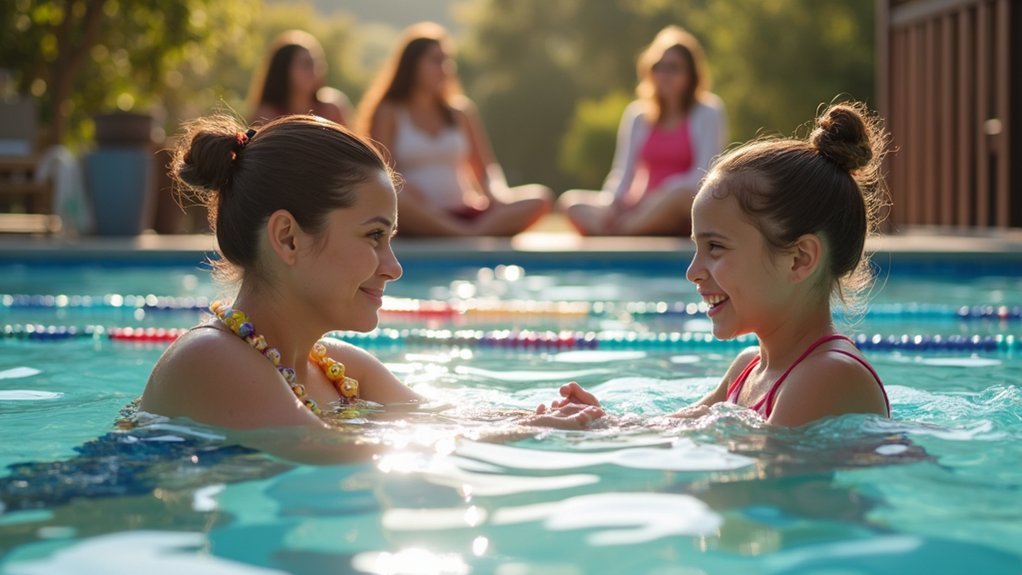
When working with special needs swimmers, you’ll need to create personalized skill ladders that break down complex movements into manageable steps.
Track and celebrate every achievement, no matter how small, to build confidence and maintain motivation throughout the learning journey.
Your framework should carefully balance appropriate challenges with opportunities for success, ensuring learners feel both stretched and accomplished as they progress through their aquatic development.
Understanding each swimmer’s unique ways of processing information is crucial when developing progressive skill paths that accommodate their individual learning styles and sensory needs.
Design Individualized Skill Ladders
Unlike traditional swim programs that follow rigid progressions, effective adaptive instruction requires building customized skill ladders for each participant.
You’ll need to collaborate with swimmers and their families to understand specific goals, challenges, and aspirations before designing individual frameworks that allow progress at appropriate paces.
Start by evaluating each swimmer’s current abilities, then create flexible pathways that might tackle skills in non-traditional sequences. This approach aligns with the iCan Swim program, which begins with initial swim assessments to establish personalized goals for participants.
Remember that some participants may excel at certain movements while needing extra support in others – your framework should accommodate these variations.
- Conduct thorough initial evaluations that identify both physical capabilities and sensory preferences
- Create visual progress charts that celebrate achievements on personalized skill paths
- Incorporate regular re-evaluation points to adjust goals and methods as the swimmer develops
Track Meaningful Small Wins
Tracking meaningful small wins forms the cornerstone of effective adaptive swim instruction. Set clear, achievable goals for each swimmer to create measurable benchmarks that motivate and demonstrate progress.
When you understand common obstacles like rigidity or water fear, you’ll better tailor your instruction strategy.
Implement a systematic monitoring framework to document improvements, however small. A swimmer who previously wouldn’t put their face in water but now willingly blows bubbles has achieved a significant milestone worth celebrating.
Foster a positive environment where these achievements receive immediate recognition. Regular review and adjustment of goals ensures instruction remains aligned with the swimmer’s developing capabilities.
Utilize adaptive tools like visual schedules or tactile cues to support skill development. These aids help swimmers understand expectations and track their own progress, building confidence through consistent, observable improvement rather than comparing performance to others.
Balance Challenge With Success
Three key principles govern the delicate balance between challenge and success in adaptive swim instruction. Your swimmers need tasks that stretch their abilities without causing frustration or fear.
Create a progressive framework that introduces new skills gradually while building on established competencies. When you understand each swimmer’s unique learning style, you’ll know exactly when to push forward and when to reinforce current skills. Understanding the difference between discomfort and distress helps determine when to challenge a swimmer versus when to ease back.
- Introduce new challenges only after swimmers demonstrate comfort with prerequisite skills
- Maintain a 3:1 ratio of success experiences to challenging moments during each lesson
- Use visual progress charts that swimmers can see and celebrate their advancement
When you thoughtfully balance challenge with success, your swimmers develop confidence alongside swimming skills—turning potential obstacles into stepping stones for achievement.
Establish Trust-Building Techniques for New Swimmers
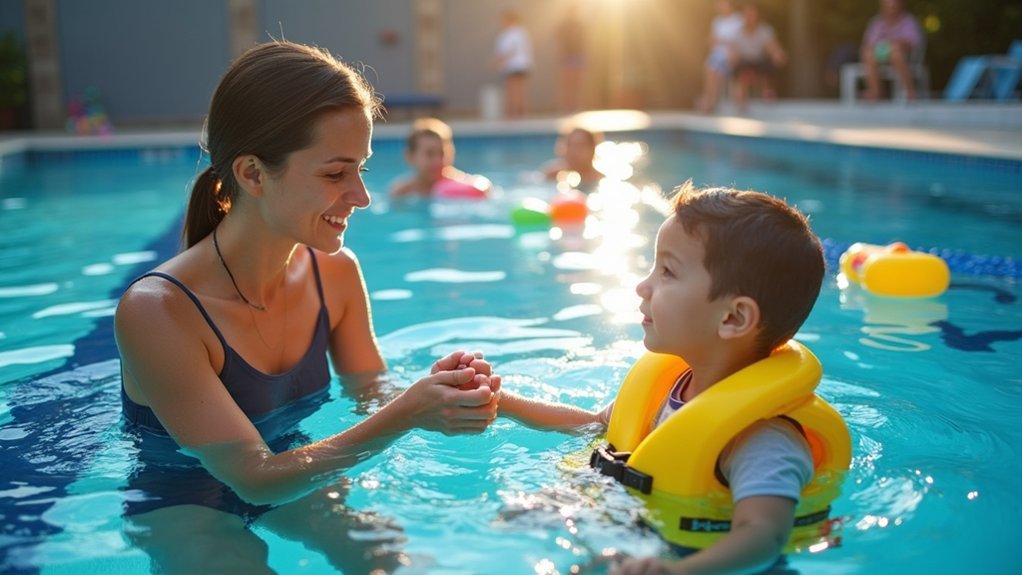
Building trust with new swimmers forms the foundation of successful adaptive swim instruction. When you create a safe psychological environment, learners can overcome their fears and anxiety about water. Start by learning each swimmer’s name and demonstrating positive interaction through frequent smiles and reassuring gestures.
Conduct thorough intake assessments by collaborating with parents to understand each learner’s unique needs and challenges. This information allows you to tailor your approach effectively.
Implement gradual exposure techniques that slowly introduce water activities without overwhelming anxious swimmers. Never stigmatize fears—instead, encourage vulnerability by acknowledging concerns with empathy. Maintaining direct eye contact throughout your lessons significantly strengthens the trust bond between instructor and student.
Maintain consistent routines while incorporating playful engagement like splashing games that help swimmers relax in the water. Remember that your reliability and positive reinforcement create the trust necessary for swimming success.
Implement Specialized Safety Protocols for High-Risk Scenarios
While building trust creates a positive environment for learning, safety must be at the core of every adaptive swim program. You’ll need thorough emergency action plans tailored to your facility and swimmers with special needs.
Make certain you’re aware of each swimmer’s medical conditions and have appropriate monitoring strategies in place, especially for those with sensory seeking behaviors who might engage in breath-holding activities. Close observation is crucial to identify potentially dangerous behaviors that require immediate intervention.
Medical awareness and vigilant monitoring are critical safeguards, particularly for sensory-seeking swimmers prone to dangerous breath-holding behaviors.
- Modify the swim-float-swim sequence based on each swimmer’s unique sensory and motor challenges, creating flexible plans that adapt to their capabilities.
- Implement structured entry and exit routines that provide additional intervention time while preventing accidents on slippery pool decks.
- Familiarize your swimmers with rescue equipment and lifeguard roles to reduce anxiety during potential emergency situations.
Connect With the Adaptive Aquatics Community
Successful adaptive swim instructors don’t work in isolation; they thrive within a supportive network of like-minded professionals and organizations.
Start by researching local aquatic facilities and disability support organizations that offer adaptive programs. Reach out to experienced instructors for mentorship opportunities and practical teaching strategies.
Join online forums and social media groups dedicated to adaptive aquatics to stay current with best practices and connect with fellow instructors.
Attend workshops, conferences, and community events focused on adaptive swimming to expand your knowledge and professional network.
Don’t forget to advocate for inclusion by collaborating with local businesses and organizations to create more opportunities for adaptive swimmers.
These connections will enhance your effectiveness as an instructor while supporting the broader adaptive aquatics community. Understanding how to develop adaptable methods for individuals with attention, coordination, and planning difficulties will be crucial to your success as an instructor.
Frequently Asked Questions
What Salary Can I Expect as an Adaptive Swim Instructor?
You’ll typically earn between $14-26 per hour as an adaptive swim instructor. Your salary will increase with experience, specialized certifications, and location, with urban areas generally offering higher rates.
How Do I Manage Emotional Meltdowns During Lessons?
You’ll manage emotional meltdowns by recognizing early signs, staying calm, using gentle tones, and providing a safe space. Offer breaks when needed and reassure swimmers without criticism after the episode subsides.
Can I Specialize in Teaching Specific Disability Types?
Yes, you can specialize in specific disability types like autism, physical disabilities, or intellectual challenges. Focus your training on these areas to develop expertise and techniques tailored to particular needs and learning styles.
What Insurance Coverage Do I Need for Adaptive Instruction?
You’ll need both general liability insurance (at least $1M per incident) and professional liability coverage ($25K+ per incident) as an adaptive instructor. Don’t forget to take into account personal accident and excess liability insurance too.
How Do I Address Parents With Unrealistic Progress Expectations?
Set clear expectations early, communicate regularly about realistic milestones, and educate parents on individual learning paces. You’ll need to address their anxieties compassionately while highlighting their child’s unique progress, however small it may seem.
In Summary
You’re now equipped to become an exceptional adaptive swim instructor. By embracing these ten strategies, you’ll create inclusive, safe, and effective aquatic experiences for swimmers of all abilities. Remember, your patience and creativity will transform lives beyond the pool. As you connect with the broader adaptive aquatics community, you’ll continue growing your skills while making swimming truly accessible for everyone. Keep learning—your impact is immeasurable.





Leave a Reply